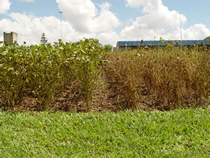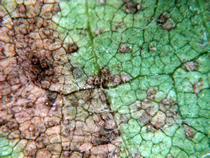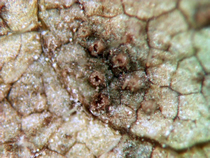By Loren J. Giesler, Former Extension Plant Pathologist
Pathogen
Soybean rust, also referred to as Asian soybean rust is caused by Phakopsora pachyrhizi and is an aggressive pathogen that, in the past ten years, has spread from Asia to Africa, South America, and now the U.S. Yield losses can be severe with this disease and losses of 10-80% have been reported. Soybean rust was first detected in the U.S. in the fall of 2004. Since this time the national sentinel plot network has been monitoring the spread and development of this disease.
Disease Symptoms
Soybean rust symptoms are most commonly observed on the leaves and will start in the lower canopy. Lesions can also develop on petioles, pods and stems. Symptom development occurs rapidly once the plant starts flowering and can result in significant levels of defoliation under favorable environmental conditions. Lesions first appear as small yellow and irregularly shaped spots. As the disease progresses, lesions enlarge to 1/16th to 1/12th of an inch in diameter, and are tan to dark reddish brown in color. Within each lesion are a few to several volcano-shaped uredinia (spore producing structures). As rust severity increases, plants prematurely lose their leaves and commonly mature early. Lesions from soybean rust can appear similar to other foliar diseases of soybean and can be confused with brown spot and bacterial pustule. See Soybean Disease Profiles I (EC1903) for more information.






Favorable Environmental Conditions
Soybean rust development is favored by temperatures ranging from 54°-84°F (65-80 F is optimum), with relative humidity above 90% for more than 12 hours. Soybean rust can be active with daytime temperatures as high as 100° F and possibly higher as long as night temperatures fall into the optimum range for disease development. In order for spores to germinate and infect the plant, six hours of continuous leaf wetness are required. Infection increases with longer leaf wetness periods up to 12 hours. In South America, significant rust development is associated with rain events.
Management
Genetic Resistance
Genetic resistance to soybean rust has been identified, but has not been shown to be durable or effective for very long. Many companies and private university programs are screening genetic material to identify new sources and combine known sources of resistance. Commercial resistant varieties are not currently available.
Cultural Practices
Planting date and maturity may influence the impact of soybean rust in some regions. Research has not been done in this area.
Chemical/Biological Control
Use of foliar fungicides to manage this disease will be critical if this disease arrives before or during the susceptible development stages in the soybean crop which is from flowering (growth stage R1) through full seed (growth stage R6). See "Fungicides to Manage Soybean Rust" link for more information on labeled products available and guidelines for curative and preventative use. When fungicides are applied after 10% disease severity (10% leaves with rust) the effectiveness of the fungicide is significantly reduced. One study showed that yields were reduced by 17% if a fungicide application was delayed one week after soybean rust was first detected in a field (at R5) and 38% if treatment was delayed two weeks.
Links
- USDA Soybean Rust Forecast
- Nebraska Extension NebGuide: Safe Use of Foliar Fungicides to Manage Crop Diseases (G1854)
- Nebraska Extension NebGuide: Foliar Fungicide Use in Soybean (G1862)
- Soybean Rust Management in the Mid Atlantic Region
- North Central Soybean Research and Information Initiative: Soybean Rust
